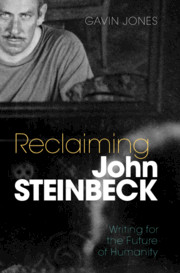Book contents
- Reclaiming John Steinbeck
- Reclaiming John Steinbeck
- Copyright page
- Dedication
- Contents
- Figures
- Acknowledgments
- Introduction Loving and Hating Steinbeck
- Chapter 1 Short Stories in School and Lab: “Tularecito” and “The Snake”
- Chapter 2 Drought, Climate, and Race in the West: To a God Unknown
- Chapter 3 Race and Revision: “The Vigilante” and “Johnny Bear”
- Chapter 4 Becoming Animal: Theories of Mind in The Red Pony
- Chapter 5 What Is It Like to Be a Plant? “The Chrysanthemums” and “The White Quail”
- Chapter 6 On Not Being a Modernist: Disability and Performance in Of Mice and Men
- Chapter 7 Emergence and Failure: The Middleness of The Grapes of Wrath
- Chapter 8 Borderlands: Extinction and the New World Outlook in Sea of Cortez
- Chapter 9 Mexican Revolutions: The Forgotten Village, The Pearl, and the Global South
- Epilogue The Aftertaste of Cannery Row
- Notes
- Index
Chapter 9 - Mexican Revolutions: The Forgotten Village, The Pearl, and the Global South
Published online by Cambridge University Press: 02 July 2021
- Reclaiming John Steinbeck
- Reclaiming John Steinbeck
- Copyright page
- Dedication
- Contents
- Figures
- Acknowledgments
- Introduction Loving and Hating Steinbeck
- Chapter 1 Short Stories in School and Lab: “Tularecito” and “The Snake”
- Chapter 2 Drought, Climate, and Race in the West: To a God Unknown
- Chapter 3 Race and Revision: “The Vigilante” and “Johnny Bear”
- Chapter 4 Becoming Animal: Theories of Mind in The Red Pony
- Chapter 5 What Is It Like to Be a Plant? “The Chrysanthemums” and “The White Quail”
- Chapter 6 On Not Being a Modernist: Disability and Performance in Of Mice and Men
- Chapter 7 Emergence and Failure: The Middleness of The Grapes of Wrath
- Chapter 8 Borderlands: Extinction and the New World Outlook in Sea of Cortez
- Chapter 9 Mexican Revolutions: The Forgotten Village, The Pearl, and the Global South
- Epilogue The Aftertaste of Cannery Row
- Notes
- Index
Summary
This chapter continues to uncover Steinbeck’s interest in Mexico (and the Mexican Revolution) and his relevance as a thinker on the Global South and its social inequalities. Turning to Steinbeck’s collaborative projects in Mexico, the documentary film about water sanitation, The Forgotten Village, and The Pearl--both novel and film made with the Mexican director Emilio Fernandez--we encounter experimental artistic forms that embody a transamerican political vision. If The Forgotten Village fails in its efforts to politicize and improve the living conditions of the indigenous peoples it depicts, then The Pearl represents a more successful attempt to participate in history. Comparing the novel and the film reveals a creative dialogue between Steinbeck and Fernandez, in which the novel’s techniques of sound and vision look forward to its existence as a film. Together with a new understanding of uncertainty and of a human consciousness extending into and capable of changing the world, The Pearl has a curious temporality that imagines society on the verge of revolutionary change.
- Type
- Chapter
- Information
- Reclaiming John SteinbeckWriting for the Future of Humanity, pp. 168 - 191Publisher: Cambridge University PressPrint publication year: 2021

